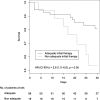Impact of species and antibiotic therapy of enterococcal peritonitis on 30-day mortality in critical care-an analysis of the OUTCOMEREA database
- PMID: 31492201
- PMCID: PMC6731585
- DOI: 10.1186/s13054-019-2581-8
Impact of species and antibiotic therapy of enterococcal peritonitis on 30-day mortality in critical care-an analysis of the OUTCOMEREA database
Abstract
Introduction: Enterococcus species are associated with an increased morbidity in intraabdominal infections (IAI). However, their impact on mortality remains uncertain. Moreover, the influence on outcome of the appropriate or inappropriate status of initial antimicrobial therapy (IAT) is subjected to debate, except in septic shock. The aim of our study was to evaluate whether an IAT that did not cover Enterococcus spp. was associated with 30-day mortality in ICU patients presenting with IAI growing with Enterococcus spp.
Material and methods: Retrospective analysis of French database OutcomeRea from 1997 to 2016. We included all patients with IAI with a peritoneal sample growing with Enterococcus. Primary endpoint was 30-day mortality.
Results: Of the 1017 patients with IAI, 76 (8%) patients were included. Thirty-day mortality in patients with inadequate IAT against Enterococcus was higher (7/18 (39%) vs 10/58 (17%), p = 0.05); however, the incidence of postoperative complications was similar. Presence of Enterococcus spp. other than E. faecalis alone was associated with a significantly higher mortality, even greater when IAT was inadequate. Main risk factors for having an Enterococcus other than E. faecalis alone were as follows: SAPS score on day 0, ICU-acquired IAI, and antimicrobial therapy within 3 months prior to IAI especially with third-generation cephalosporins. Univariate analysis found a higher hazard ratio of death with an Enterococcus other than E. faecalis alone that had an inadequate IAT (HR = 4.4 [1.3-15.3], p = 0.019) versus an adequate IAT (HR = 3.1 [1.0-10.0], p = 0.053). However, after adjusting for confounders (i.e., SAPS II and septic shock at IAI diagnosis, ICU-acquired peritonitis, and adequacy of IAT for other germs), the impact of the adequacy of IAT was no longer significant in multivariate analysis. Septic shock at diagnosis and ICU-acquired IAI were prognostic factors.
Conclusion: An IAT which does not cover Enterococcus is associated with an increased 30-day mortality in ICU patients presenting with an IAI growing with Enterococcus, especially when it is not an E. faecalis alone. It seems reasonable to use an IAT active against Enterococcus in severe postoperative ICU-acquired IAI, especially when a third-generation cephalosporin has been used within 3 months.
Keywords: Antibiotic therapy; Enterococcus spp.; Intensive care; Intraabdominal infections; Mortality.
Conflict of interest statement
The authors declare that they have no competing interests.
Figures
References
-
- Riché FC, Dray X, Laisné M-J, Matéo J, Raskine L, Sanson-Le Pors M-J, et al. Factors associated with septic shock and mortality in generalized peritonitis: comparison between community-acquired and postoperative peritonitis. Crit Care Lond Engl. 2009;13(3):R99. doi: 10.1186/cc7931. - DOI - PMC - PubMed
MeSH terms
Substances
LinkOut - more resources
Full Text Sources
Medical
Miscellaneous



